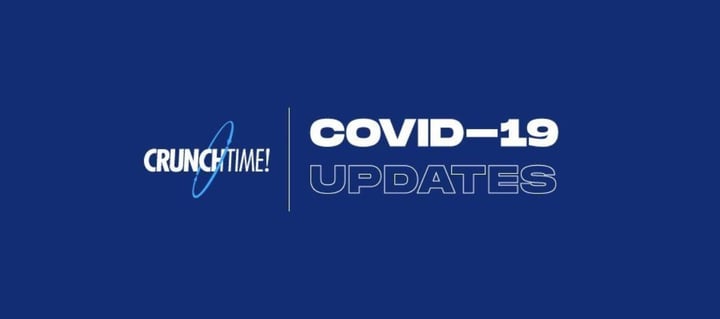
- Home
- Crunchtime Blog
- How Technology is Helping Restaurants Alleviate the Strains of the Labor Crunch

How Technology is Helping Restaurants Alleviate the Strains of the Labor Crunch
Restaurants feeling the strain of a shrinking labor pool are turning to technology for help. A panel of industry leaders at the Restaurant Leadership Conference in Phoenix, Arizona discussed how through the use of technology, they are empowering team members and addressing some of the labor challenges the industry is facing today.
Panelists included:
TJ Schier, Chief Operating Officer for BigShots Golf
Clint Lautenschleger, Senior Vice President of Human Resources for Restaurant Growth Services
John Welch, Regional Vice President of Operations for Jersey Mike’s Subs
Dave Altmann, Co-Director of Operations for Jersey Mike’s Subs
Anthony Mejia, Vice President of Information Technology for Zippy’s Restaurants.
The session was moderated by Ted Ruscitti, Chief Experience Officer at CrunchTime.
How does the use of technology impact a candidate's decision during the hiring process?
Altmann: “You want to make that process as simple as possible, especially right now with the younger generation. They are very used to operating from their phones, and you need to have a simple, easy-to-use process that they can grab on to.”
Schier: “It’s like fishing: when you feel a nibble on the hook you have to set the hook and reel them in. If you email a candidate and they don’t email back, well they don’t check their email. If you’re on an archaic system, good luck getting anyone to work for you.”
Lautenschleger: “It’s a leading indicator as to what the rest of the experience is going to look like. If it’s a miserable, manual experience at the beginning, it’s not going to get better later on. It’s like the first date, nothing is going to be better than the first date so that’s how we’re thinking about it.”
What strategies do you use to improve retention during and after onboarding?
Lautenschleger: “What’s interesting is that we analyzed where our turnover happens. Everybody says in restaurants that it’s always the first 30 days. But our 30- to 90-day turnover is triple that. While we’ve used learning management technology to really cut down the turnover early on, now we’re shifting our focus to how to use it to drive turnover down from 30 to 90 days.”
Schier: “When you come in to work for [BigShots Golf], that first hour you’re playing golf, in our tee box, eating food – we literally serve you like a guest. The first hour of your experience is you’re our guest. We have shown you that everything we’re going to do in training is around the guest experience. We do a great job in the first 30 days, but when the training is done, that’s when the LMS really comes into play to give people a roadmap to get ahead and have a path with you so they don’t just quit right away. If you just get them the first week of training, they’re done.”
Welch: “We spend time together with our operators in the stores identifying who they want to move into leadership roles. But it’s that middle of the road – past 90 days but not necessarily in our leadership programs yet – they can get missed in that puzzle.”
How are you using labor management and scheduling tools to help navigate the labor crunch?
Welch: “It’s no secret, we’re all here in this room because it’s a struggle. We hire a lot of young people, but we’re going after the high-quality people, and tracking that type of person down is much more difficult than it’s ever been. Let’s be honest, they’re probably going to school, in extracurricular activities, playing a sport, or have another job, so they need a lot of flexibility. Using an app where they can switch out shifts or block off their availability makes that possible.”
Altmann: “If [people leave because] it’s a flexibility thing, that can be solved in a lot of ways through this technology. Use the tools, give your people the flexibility, give the oxygen to folks who need it and the rest will generally wash itself out.”
What tools do you use to save your restaurant operators time and reduce their daily tasks?
Welch: “[CrunchTime’s] AvT is at the center of what our operators use on a daily basis – it’s huge for them. Previous to us having that, if you were dealing with a food cost issue, lots of time and energy was spent trying to solve those issues. This AvT report just dials that down for us. It gives you exactly what those issues are so you can create a gameplan designed to deal with that issue. It really cuts down on the time it takes to fix those issues. At the end of the day, we all want high-quality operators in our stores and keeping those folks happy and motivated is key. So we need to give them the tools that they can use to succeed.”
Schier: “It’s great that I know my food cost is off and that my labor is too high, but what do I do about it? That’s where it really comes to training. As an example, if we’re having a food cost issue at a venue then the training team sends out microlearning to everybody who works in culinary with specific things they need to focus on to help us lower food costs. They then send separate training to the servers, for example, saying ‘make sure you ring things up right, focus on things that are profitable.’ One step is to know you have a problem, and the second step is putting some tools out there to reinforce the behaviors to get the results you’re looking for.”
Mejia: “Prior to having the commissary function, we were trying to have our restaurants talk to the commissary, see how much food they could get, what products they needed. It was very difficult, with lots of emails, text messages, those types of things that just get lost. CrunchTime’s commissary functionality was a game-changer. The commissary tool really allowed us to consolidate our business and treat our restaurants no different than we would the commissary, bakeries, and catering concepts as well. It put us in a unified platform that created a lot of efficiencies from a communication and ordering perspective.”
What are future opportunities you see that could help alleviate labor pressures?
Lautenschleger: “I think what we’re seeing is that you almost can’t move fast enough right now. But what does the future of this work thing look like? People don’t really want to work 50 hours a week, so why would we make them work 50 hours a week, even at the management level? What if in the future restaurant managers only work 20 hours or 25 hours a week and they prefer to have three or four gigs? Think about the people I can improve if I have the right technology to support that model. I guarantee you a using a spiral notebook to try to figure that out is not going to be a winning strategy.”
Schier: “We’re going to build 5 or 6 of these massive venues per year and I want to promote everybody from within. The value of an LMS is having that training platform to give that team member a roadmap and give the managers, and especially the GMs, the tool to be successful.”
Mejia: “The labor crunch that we’re all experiencing in the hospitality industry has shifted a lot of responsibility from our teammates to our guests. We’re using our devices a lot more in the restaurant, like making your own payments yourself, or maybe you’re putting your own discounts on your check using the app. So there’s a lot more dependency on your devices, and I think that’s going to continue to grow and grow. It’s like at the grocery store, they used to take all of the groceries out of your cart and run it, and now you do it yourself. And gas stations all used to be full service. That’s all triggered by labor. We have a hard time hiring enough people to do all of the work so we need to distribute that work while not making the customer feel like they’re out there doing all the work and should be getting a paycheck too.”
Altmann: “We’ve got to keep providing tools that will help all these franchisees make the best decisions they can in their restaurants. We need to make sure that the people who already work for Jersey Mike’s now like what they’re doing and like the programs that we put in place. We need to make it easy for them to learn, make it easy for them to sign up with the company, and ensure they want to stay with the company, so they want to bring their friends in. In our recruitment process we’re always looking left and right before we move out in terms of hiring because that’s where your best people are going to come from: friends and family of people who already work for you. If you’ve got a fun atmosphere with the right technology, you’re likely to get more like-minded people.”
Share this post
Related


Talking With Garrett Tietjen, Labor Product Manager

